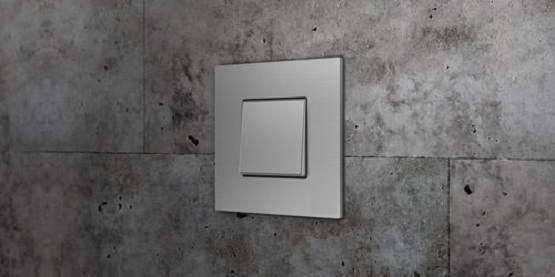Electrical wiring, a light switch is a switch most commonly used to operate electric lights, permanently connected equipment, or electrical outlets. Portable lamps such as table lamps may have a light switch mounted on the double wall outlet socket, base, or in-line with the cord. Manually operated on/off switches may be substituted by dimmer switches that allow controlling the brightness of lamps as well as turning them on or off, time-controlled switches, occupancy-sensing switches, and remotely controlled switches and dimmers. Light switches are also found in flashlights, vehicles, and other devices.

Switches for lighting may be in hand-held devices, moving vehicles, and buildings. Residential and commercial buildings usually have wall-mounted light switches to control lighting within a room. Mounting height, visibility, and other design factors vary from country to country. The switch mounting boxes, or enclosures are often recessed within a finished wall. Surface mounting of enclosures is also fairly common though is seen more in commercial industrial and outbuilding settings than in residential structures. These modern light switch boxes (a pattress box) are designed to house and mount the switch(s), protect the wiring and contain any heat or fire. Each kind uses some form of a plastic, ceramic, or metal cover to prevent accidental contact with live terminals of the switch. Wall plates are available in different styles and colours to blend in with the style of a room, also available in weatherproof varieties for outdoors. These covers are usually quite easy to mount.
The first light switch employing quick-break technology was invented by John Henry Holmes in 1884 in the Shieldfield district of Newcastle upon Tyne. The "quick-break" switch overcame the problem of a switch's contacts developing electric arcing whenever the circuit was opened or closed. Arcing would cause pitting on one contact and the build-up of residue on the other, and the switch's useful life would be diminished. Holmes' invention ensured that the contacts would separate or come together very quickly, however much or little pressure was exerted by the user on the switch actuator. The action of this "quick break" mechanism meant that there was insufficient time for an arc to form, and the switch would thus have a long working life. This "quick break" technology is still in use in almost every ordinary light switch in the world today, numbering in the billions, as well as in many other forms of electric switch.
The toggle light switch was invented in 1897 by William J. Newton.
As a component of an electrical writing or home wirting system, the installation of light switches is regulated by some authority concerned with safety and standards. In different countries the standard dimensions of the wall mounting hardware (boxes, plates, etc.) may differ. Since the face-plates used must cover this hardware, these standards determine the minimum sizes of all wall mounted equipment. Hence, the shape and size of the boxes and face-plates, as well as what is integrated, varies from country to country.
The dimensions, mechanical designs, and even the general appearance of light switches have changed slowly over time. Switches typically remain in service for many decades, often being changed only when a portion of a house is rewired. It is not unusual to see century-old light switches still in functional use. Manufacturers introduce various new forms and styles, but for the most part decoration and fashion concerns are limited to the face-plates or wall-plates. Even the "modern" dimmer switch with knob is at least forty years old, and in even the newest construction the familiar toggle and rocker switch formats predominate.